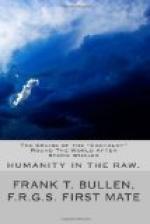CHAPTER XXVI — PADDY’S LATEST EXPLOIT We try Preservation Inlet—An astounding feat of Paddy Gilroy’s.
Chapter XXVII — port Pegasus Port Pegasus—Among old acquaintances—“Mutton birds”— Skilled auxiliaries—A gratifying catch—Leave port again —Back to the Solander—A grim escape—Our last whales —Into Port William again—Paddy’s assistance—We part with our Kanakas—Sam’s plans of conquest.
Chapter XXVIII — to the bluff, and home And last—In high-toned company—Another picnic—Depart from the Bluff—Hey for the Horn!—Among the icebergs— “Scudding”—Favouring trades—A narrow escape from collision—Home at last.
*
INTRODUCTION
Without attempting the ambitious task of presenting a comprehensive sketch of the origin, rise, and fall of whale-fishing as a whole, it seems necessary to give a brief outline of that portion of the subject bearing upon the theme of the present book before plunging into the first chapter.
This preliminary is the more needed for the reason alluded to in the Preface—the want of knowledge of the subject that is apparent everywhere. The Greenland whale fishery has been so popularized that most people know something about it; the sperm whale fishery still awaits its Scoresby and a like train of imitators and borrowers.
Cachalots, or sperm whales, must have been captured on the coasts of Europe in a desultory way from a very early date, by the incidental allusions to the prime products spermaceti and ambergris which are found in so many ancient writers, Shakespeare’s reference—“The sovereign’st thing on earth was parmaceti for an inward bruise”—will be familiar to most people, as well as Milton’s mention of the delicacies at Satan’s feast—“Grisamber steamed”—not to carry quotation any further.
But in the year 1690 the brave and hardy fishermen of the north-east coasts of North America established that systematic pursuit of the cachalot which has thriven so wonderfully ever since, although it must be confessed that the last few years have witnessed a serious decline in this great branch of trade.
For many years the American colonists completely engrossed this branch of the whale fishery, contentedly leaving to Great Britain and the continental nations the monopoly of the northern or Arctic fisheries, while they cruised the stormy, if milder, seas around their own shores.
For the resultant products, their best customer was the mother country, and a lucrative commerce steadily grew up between the two countries. But when the march of events brought the unfortunate and wholly unnecessary War of Independence, this flourishing trade was the first to suffer, and many of the daring fishermen became our fiercest foes on board their own men-of-war.




